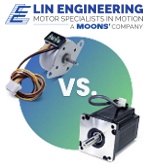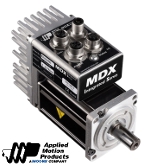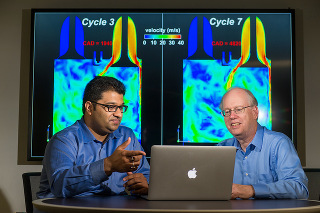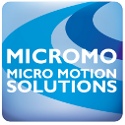 |
| September 15, 2015 | Volume 11 Issue 35 |
Motion Control News & Products
Designfax weekly eMagazine
Archives
Partners
Manufacturing Center
Product Spotlight
Modern Applications News
Metalworking Ideas For
Today's Job Shops
Tooling and Production
Strategies for large
metalworking plants
Choosing a stepper motor: PM or hybrid?
 Lin Engineering stepper motors are widely used in various applications that require precise control of motion, such as in robotics, 3D printing, CNC machines, and medical equipment. There are two main types of stepper motors: permanent magnet (PM) and hybrid. Learn the differences, advantages, and when to use one type or the other.
Lin Engineering stepper motors are widely used in various applications that require precise control of motion, such as in robotics, 3D printing, CNC machines, and medical equipment. There are two main types of stepper motors: permanent magnet (PM) and hybrid. Learn the differences, advantages, and when to use one type or the other.
Read this informative Lin Engineering article.
Top Product: Integrated servo system is 20% smaller than standalone unit
 Applied Motion Products has introduced the MDX+ series, a family of low-voltage servo systems that integrate a servo drive, motor, and encoder into one package. This all-in-one drive unit is an ideal solution for manufacturers in logistics, AGV, medical, semiconductor, the solar industries, and many others.
Applied Motion Products has introduced the MDX+ series, a family of low-voltage servo systems that integrate a servo drive, motor, and encoder into one package. This all-in-one drive unit is an ideal solution for manufacturers in logistics, AGV, medical, semiconductor, the solar industries, and many others.
Read the full article.
Overhung load adaptors provide load support and contamination protection
 Overhung load adaptors (OHLA) provide both overhung radial and axial load support to protect electrified mobile equipment motors from heavy application loads, extending the lifetime of the motor and alleviating the cost of downtime both from maintenance costs and loss of production. They seal out dirt, grime, and other contaminants too. Zero-Max OHLAs are available in an extensive offering of standard models (including Extra-Duty options) for typical applications or customized designs.
Overhung load adaptors (OHLA) provide both overhung radial and axial load support to protect electrified mobile equipment motors from heavy application loads, extending the lifetime of the motor and alleviating the cost of downtime both from maintenance costs and loss of production. They seal out dirt, grime, and other contaminants too. Zero-Max OHLAs are available in an extensive offering of standard models (including Extra-Duty options) for typical applications or customized designs.
Learn more.
Why choose electric for linear actuators?
 Tolomatic has been delivering a new type of linear motion technology that is giving hydraulics a run for its money. Learn the benefits of electric linear motion systems, the iceberg principle showing total cost of ownership, critical parameters of sizing, and conversion tips.
Tolomatic has been delivering a new type of linear motion technology that is giving hydraulics a run for its money. Learn the benefits of electric linear motion systems, the iceberg principle showing total cost of ownership, critical parameters of sizing, and conversion tips.
Get this informative e-book. (No registration required)
New AC hypoid inverter-duty gearmotors
 Bodine Electric Company introduces 12 new AC inverter-duty hypoid hollow shaft gearmotors. These type 42R-25H2 and 42R-30H3 drives combine an all-new AC inverter-duty, 230/460-VAC motor with two hypoid gearheads. When used with an AC inverter (VFD) control, these units deliver maintenance-free and reliable high-torque output. They are ideal for conveyors, gates, packaging, and other industrial automation equipment that demands both high torque and low power consumption from the driving gearmotor.
Bodine Electric Company introduces 12 new AC inverter-duty hypoid hollow shaft gearmotors. These type 42R-25H2 and 42R-30H3 drives combine an all-new AC inverter-duty, 230/460-VAC motor with two hypoid gearheads. When used with an AC inverter (VFD) control, these units deliver maintenance-free and reliable high-torque output. They are ideal for conveyors, gates, packaging, and other industrial automation equipment that demands both high torque and low power consumption from the driving gearmotor.
Learn more.
Next-gen warehouse automation: Siemens, Universal Robots, and Zivid partner up
 Universal Robots, Siemens, and Zivid have created a new solution combining UR's cobot arms with Siemens' SIMATIC Robot Pick AI software and Zivid's 3D sensors to create a deep-learning picking solution for warehouse automation and intra-logistics fulfillment. It works regardless of object shape, size, opacity, or transparency and is a significant leap in solving the complex challenges faced by the logistics and e-commerce sectors.
Universal Robots, Siemens, and Zivid have created a new solution combining UR's cobot arms with Siemens' SIMATIC Robot Pick AI software and Zivid's 3D sensors to create a deep-learning picking solution for warehouse automation and intra-logistics fulfillment. It works regardless of object shape, size, opacity, or transparency and is a significant leap in solving the complex challenges faced by the logistics and e-commerce sectors.
Read the full article.
Innovative DuoDrive gear and motor unit is UL/CSA certified
 The DuoDrive integrated gear unit and motor from NORD DRIVE-SYSTEMS is a compact, high-efficiency
solution engineered for users in the fields of intralogistics, pharmaceutical, and the food and beverage industries. This drive combines a IE5+ synchronous motor and single-stage helical gear unit into one compact housing with a smooth, easy-to-clean surface. It has a system efficiency up to 92% and is available in two case sizes with a power range of 0.5 to 4.0 hp.
The DuoDrive integrated gear unit and motor from NORD DRIVE-SYSTEMS is a compact, high-efficiency
solution engineered for users in the fields of intralogistics, pharmaceutical, and the food and beverage industries. This drive combines a IE5+ synchronous motor and single-stage helical gear unit into one compact housing with a smooth, easy-to-clean surface. It has a system efficiency up to 92% and is available in two case sizes with a power range of 0.5 to 4.0 hp.
Learn more.
BLDC flat motor with high output torque and speed reduction
 Portescap's 60ECF brushless DC slotted flat motor is the newest frame size to join its flat motor portfolio. This 60-mm BLDC motor features a 38.2-mm body length and an outer-rotor slotted configuration with an open-body design, allowing it to deliver improved heat management in a compact package. Combined with Portescap gearheads, it delivers extremely high output torque and speed reduction. Available in both sensored and sensorless options. A great choice for applications such as electric grippers and exoskeletons, eVTOLs, and surgical robots.
Portescap's 60ECF brushless DC slotted flat motor is the newest frame size to join its flat motor portfolio. This 60-mm BLDC motor features a 38.2-mm body length and an outer-rotor slotted configuration with an open-body design, allowing it to deliver improved heat management in a compact package. Combined with Portescap gearheads, it delivers extremely high output torque and speed reduction. Available in both sensored and sensorless options. A great choice for applications such as electric grippers and exoskeletons, eVTOLs, and surgical robots.
Learn more and view all the specs.
Application story: Complete gearbox and coupling assembly for actuator system
 Learn how GAM engineers not only sized and selected the appropriate gear reducers and couplings required to drive two ball screws in unison using a single motor, but how they also designed the mounting adapters necessary to complete the system. One-stop shopping eliminated unnecessary components and resulted in a 15% reduction in system cost.
Learn how GAM engineers not only sized and selected the appropriate gear reducers and couplings required to drive two ball screws in unison using a single motor, but how they also designed the mounting adapters necessary to complete the system. One-stop shopping eliminated unnecessary components and resulted in a 15% reduction in system cost.
Read this informative GAM blog.
Next-gen motor for pump and fan applications
 The next evolution of the award-winning Aircore EC motor from Infinitum is a high-efficiency system designed to power commercial and industrial applications such as HVAC fans, pumps, and data centers with less energy consumption, reduced emissions, and reduced waste. It features an integrated variable frequency drive and delivers upward of 93% system efficiency, as well as class-leading power and torque density in a low-footprint package that is 20% lighter than the previous version. Four sizes available.
The next evolution of the award-winning Aircore EC motor from Infinitum is a high-efficiency system designed to power commercial and industrial applications such as HVAC fans, pumps, and data centers with less energy consumption, reduced emissions, and reduced waste. It features an integrated variable frequency drive and delivers upward of 93% system efficiency, as well as class-leading power and torque density in a low-footprint package that is 20% lighter than the previous version. Four sizes available.
Learn more.
Telescoping linear actuators for space-constrained applications
 Rollon's new TLS telescoping linear actuators enable long stroke lengths with minimal closed lengths, which is especially good for applications with minimal vertical clearance. These actuators integrate seamlessly into multi-axis systems and are available in two- or three-stage versions. Equipped with a built-in automated lubrication system, the TLS Series features a synchronized drive system, requiring only a single motor to achieve motion. Four sizes (100, 230, 280, and 360) with up to 3,000-mm stroke length.
Rollon's new TLS telescoping linear actuators enable long stroke lengths with minimal closed lengths, which is especially good for applications with minimal vertical clearance. These actuators integrate seamlessly into multi-axis systems and are available in two- or three-stage versions. Equipped with a built-in automated lubrication system, the TLS Series features a synchronized drive system, requiring only a single motor to achieve motion. Four sizes (100, 230, 280, and 360) with up to 3,000-mm stroke length.
Learn more.
Competitively priced long-stroke parallel gripper
 The DHPL from Festo is a new generation of pneumatic long-stroke grippers that offers a host of advantages for high-load and high-torque applications. It is interchangeable with competitive long-stroke grippers and provides the added benefits of lighter weight, higher precision, and no maintenance. It is ideal for gripping larger items, including stacking boxes, gripping shaped parts, and keeping bags open. It has high repetition accuracy due to three rugged guide rods and a rack-and-pinion design.
The DHPL from Festo is a new generation of pneumatic long-stroke grippers that offers a host of advantages for high-load and high-torque applications. It is interchangeable with competitive long-stroke grippers and provides the added benefits of lighter weight, higher precision, and no maintenance. It is ideal for gripping larger items, including stacking boxes, gripping shaped parts, and keeping bags open. It has high repetition accuracy due to three rugged guide rods and a rack-and-pinion design.
Learn more.
Extend your range of motion: Controllers for mini motors
 FAULHABER has added another extremely compact Motion Controller without housing to its product range. The new MC3603 controller is ideal for integration in equipment manufacturing and medical tech applications. With 36 V and 3 A (peak current 9 A), it covers the power range up to 100 W and is suitable for DC motors with encoder, brushless drives, or linear motors.
FAULHABER has added another extremely compact Motion Controller without housing to its product range. The new MC3603 controller is ideal for integration in equipment manufacturing and medical tech applications. With 36 V and 3 A (peak current 9 A), it covers the power range up to 100 W and is suitable for DC motors with encoder, brushless drives, or linear motors.
Learn more.
When is a frameless brushless DC motor the right choice?
 Frameless BLDC motors fit easily into small, compact machines that require high precision, high torque, and high efficiency, such as robotic applications where a mix of low weight and inertia is critical. Learn from the experts at SDP/SI how these motors can replace heavier, less efficient hydraulic components by decreasing operating and maintenance costs. These motors are also more environmentally friendly than others.
Frameless BLDC motors fit easily into small, compact machines that require high precision, high torque, and high efficiency, such as robotic applications where a mix of low weight and inertia is critical. Learn from the experts at SDP/SI how these motors can replace heavier, less efficient hydraulic components by decreasing operating and maintenance costs. These motors are also more environmentally friendly than others.
View the video.
Tiny and smart: Step motor with closed-loop control
 Nanotec's new PD1-C step motor features an integrated controller and absolute encoder with closed-loop control. With a flange size of merely 28 mm (NEMA 11), this compact motor reaches a max holding torque of 18 Ncm and a peak current of 3 A. Three motor versions are available: IP20 protection, IP65 protection, and a motor with open housing that can be modified with custom connectors. Ideal for applications with space constraints, effectively reducing both wiring complexity and installation costs.
Nanotec's new PD1-C step motor features an integrated controller and absolute encoder with closed-loop control. With a flange size of merely 28 mm (NEMA 11), this compact motor reaches a max holding torque of 18 Ncm and a peak current of 3 A. Three motor versions are available: IP20 protection, IP65 protection, and a motor with open housing that can be modified with custom connectors. Ideal for applications with space constraints, effectively reducing both wiring complexity and installation costs.
Learn more.
Argonne pushing boundaries of computing in engine simulations
By Greg Cunningham, Argonne National Laboratory
When you're trying to understand the complex inner workings of a virtual engine, with its millions of variables and untold number of uncertainties, the most important horsepower number isn't the one under the hood; it's the one in the computer rack next door.
Researchers at the U.S. Department of Energy's Argonne National Laboratory will be testing the limits of computing horsepower this year with a new simulation project from the Virtual Engine Research Institute and Fuels Initiative (VERIFI) that will harness 60 million computer core hours to dispel those uncertainties and pave the way to more effective engine simulations.

Argonne principal mechanical engineer Sibendu Som (left) and computational scientist Raymond Bair discuss combustion engine simulations conducted by the Virtual Engine Research Institute and Fuels Initiative (VERIFI). The initiative will be running massive simulations on Argonne's Mira supercomputer to gain further insight into the inner workings of combustion engines.
The work will be conducted on MIRA, which is currently the fifth-fastest supercomputer in the world and serves as the epicenter of the Argonne Leadership Computing Facility (ALCF), a DOE Office of Science User Facility. VERIFI has been working for two years to gain a deeper understanding of the complex dynamics at work in engine combustion. While VERIFI has used powerful computers before, it has never accessed a computer with the horsepower of MIRA and the abilities to unlock the deepest secrets of combustion.
"This has the potential to be pioneering work, because we haven't seen anyone really trying to understand these boundary conditions, model parameters, and uncertainties at this level of detail," said Sibendu Som, principal investigator and principal mechanical engineer at Argonne's Center for Transportation Research. "You really need access to these types of computing resources to resolve these questions."
The research will focus on investigating how multiple variables, or uncertainties, interact simultaneously to impact the functioning of an engine. The variables in an engine are vast and include such things as temperature of cylinders and pistons, pressure inside the cylinder, and flow rates of fuels. Tiny changes in any of these conditions can have profound effects on engine performance and emissions.
In the past, slower computers allowed researchers to change one variable to see how it affected the rest. With a supercomputer, the Argonne team will be able to change all of the variables simultaneously and simulate the impact each has on all the others. The overall simulation effort will likely involve about a million calculations to resolve all the variables.
By resolving the uncertainties in engine simulations, the Argonne team will be providing vehicle manufacturers and engine designers with the tools to create more efficient engines faster and at reduced cost. The results from the study will be released publicly and will also be integrated into the CONVERGE engine simulation software created by Convergent Science, Inc.
"This is a unique opportunity to provide the power of the ALCF to designers everywhere to help improve the products we drive every day," said Convergent Science's co-founder Kelly Senecal. "By doing these simulations in advance, we will, in effect, be able to provide the benefits of a supercomputer to designers who couldn't normally access such a powerful machine."
A primary focus of the research will be enabling a new generation of gasoline compression engines that operate on the basis of low-temperature combustion. A gasoline compression engine combines many of the benefits of diesel and gasoline engines by using compression to ignite the fuel in the same manner used by diesels. Vehicle manufacturers have shown interest in pursuing low-temperature combustion as an innovative route to more efficient engines.
The project is funded by DOE's Office of Vehicle Technologies within the Office of Energy Efficiency & Renewable Energy.
Published September 2015
Rate this article
View our terms of use and privacy policy

